Using the Carbon Workflow for Mass Customization
Additive manufacturing should enable mass customization of every consumer and medical device product at scale. However, without an end-to-end workflow, it can be daunting and expensive to mass-produce a product that requires customization. There are already many custom medical and dental applications; for example, there are millions of dental aligners printed every year, and no two are identical. However, what do all of these applications have in common? They are based on custom software and workflows, so they require a lot of work to put together.
Carbon developed an approach to enable product companies to rapidly and efficiently print new products tailored to each user. This standard methodology and software can be implemented quickly and efficiently. For example, it took CCM Hockey seven months from “idea to ice” to launch Super Tacks-X Helmet with Nest Tech, the first-ever NHL-certified 3D-printed hockey helmet liner that is custom fitted.
Carbon’s methodology enables rapid and efficient production of customized parts tailored to each user. This approach has the potential to unlock new business ideas and products through mass customization and overcome current market challenges. With Carbon’s workflow-driven approach, customization doesn’t have to be expensive, making it accessible and feasible.
The Idea-to-Production Platform
You have a great idea to produce widgets and you want to attempt to customize them to fit each individual user. If you’ve never used additive manufacturing, you will have a lot of questions about how to have both a basic design and adjust it to meet the user requirements. Some of these questions may include:
- How do I capture data from the user?
- How do I input data into the design?
- How do I generate and validate each design?
- How do I send the design to the printer?
- How do I make sure all these software systems can communicate with each other?
How does Carbon’s idea-to-production platform make mass customization possible? It provides a workflow to guide a product through the concept, development, and production phases. The following figure shows how the Carbon platform works alongside your development process.
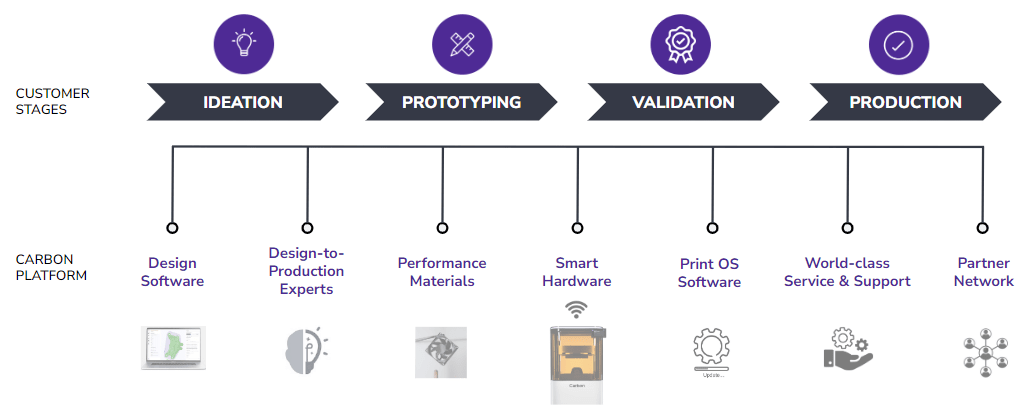
Design for Additive Manufacturing (DfAM) Software
Carbon’s workflow integrates well with customer product design stages because it works with basic file types that are versatile enough to use with software and systems most companies already have. While Carbon’s print preparation software, included with the printer, is necessary to communicate with the printer and tell it exactly how to print the file, any software that can import/export CAD and CAE files should be compatible. The following figure shows the file types and software needed to implement the Carbon workflow.

While you do not have to use one of Carbon’s design software options, CogniCAD or Carbon Design Engine,™ both can greatly aid the design and validation process. CogniCAD lightweights your design, ultimately saving you time and materials. Carbon Design Engine can help you customize lattice-based designs on a large scale and can help simulate the performance of different materials. Depending on the product you are creating, these features can prove crucial to finding the most efficient way to produce your design.
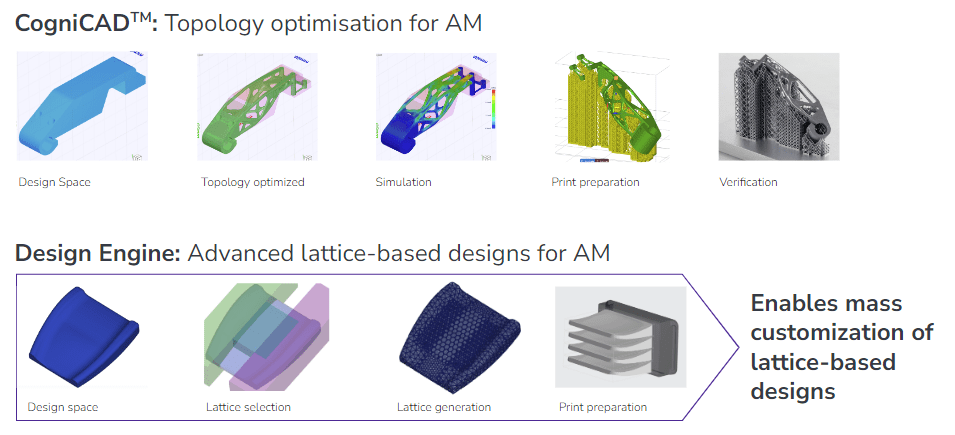
Steps to Mass Customization
So how exactly would this work? At a top level, the workflow lines up with most product development processes, but it provides specific points to consider customization, materials, and AM-specific features.

Concept Phase
In the concept phase, the project goals must be defined before you can begin the design process. Once defined, you can explore materials, rapidly iterate through designs, and compare them against nominal characterized performance to determine how to meet your specific goals. This is also the point at which you can make customization decisions. For example, scanned data can be applied to customize the fit of the final product, and pressure data can be used to customize the structure of metamaterials for cushioning or energy return. This is also when user requests like design to accommodate existing injuries or problem areas can be applied and requests about the lattice design, texture, or other features can be incorporated.
Development and Validation Phase
Using the data gathered in the concept phase, the final material and metamaterial selection is made in the development and validation phase. This is also when the design is optimized for manufacturing, including flattening, adding a base, and wrapping the geometry to be conformal. These customizations can then be validated on representative samples to define process QC parameters, understand performance targets, and define print success.
Production and Launch Phase
Now that the design has been developed and samples have been validated, the process of producing custom parts on a large scale can be optimized for commercialization. The scan or input can be imported into Carbon Design Engine and printer software to generate the design file for the part, and then prepared for printing. At this point, the part can be printed by a contract manufacturer in the Carbon Production Network, checked for quality, and shipped.
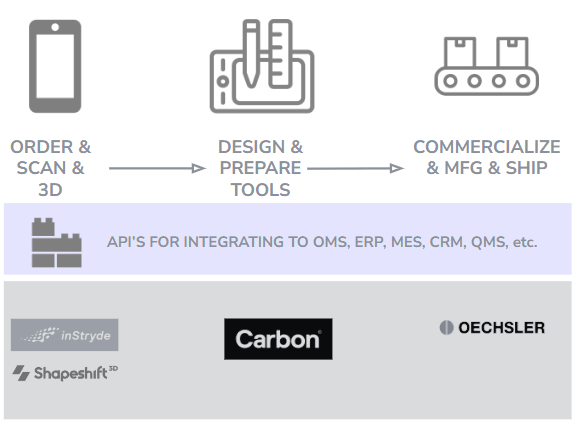
The Carbon Workflow in Action
How did our customers do it? They followed the methodology described, built on a common platform, and leveraged Carbon’s ecosystem of software and services partners.
Let’s examine the CCM Super Tacks-X Helmet with Nest Tech example more closely. How did it only take seven months from “idea to ice” to launch an NHL-certified, custom-fit, 3D-printed hockey helmet?
CCM successfully applied the Carbon workflow to produce custom hockey helmets. User-specific data was captured through a scan using an iPad, generating a design without any manual intervention. All the parts were designed using Carbon Design Engine Pro, which can create a part with multiple stiffness zones and smooth transitions between lattice types, leading to superior performance. The result was a high-performance, perfectly fitted helmet with improved breathability, because air flows better in an open lattice than in closed-cell foam.
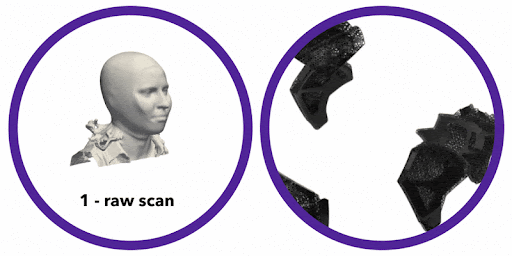
Using the same Carbon production workflow, InStryde captures the preferences and scans from their customers to design and create custom orthotics, as shown below.
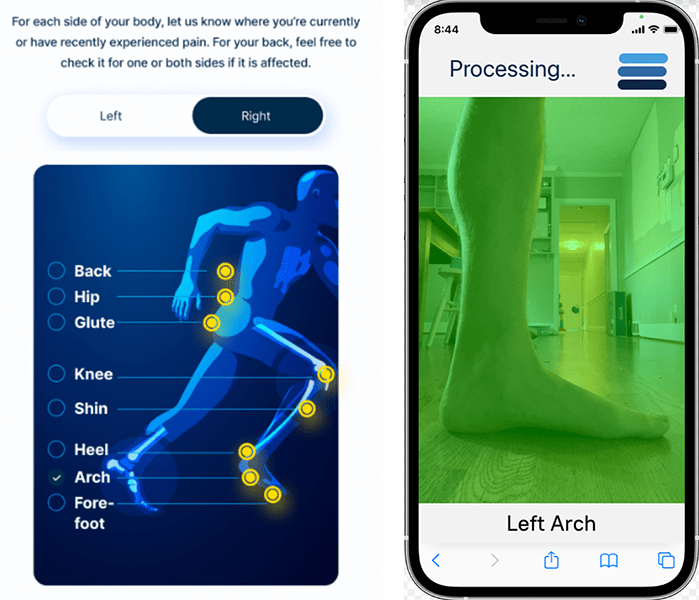
A program in Carbon Design Engine then tokenizes that personal data and applies it to the orthotic design. The build prep generation software then nests the designs to print at scale via APIs.
One of the great advantages of AM over injection molding is the opportunity to customize each piece to the end user. This dream is realized when the right workflow is put in place to take user data, apply it to the general product design, validate it, and print it. The workflow Carbon customers use has proven successful across industries.
If you’d like to learn more about any of these topics, please contact us at info@carbon3d.com or, for existing customers, through your account manager.
